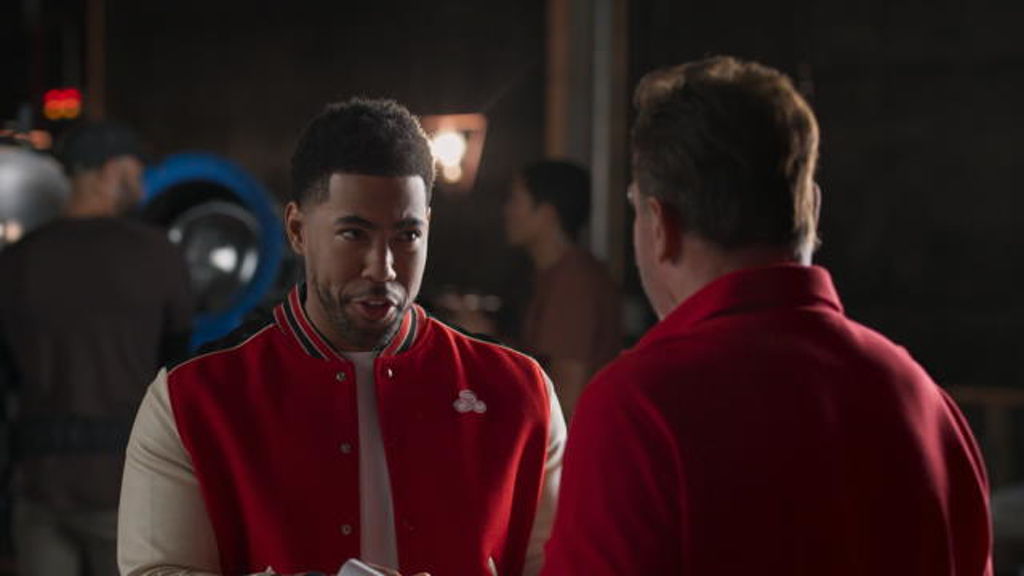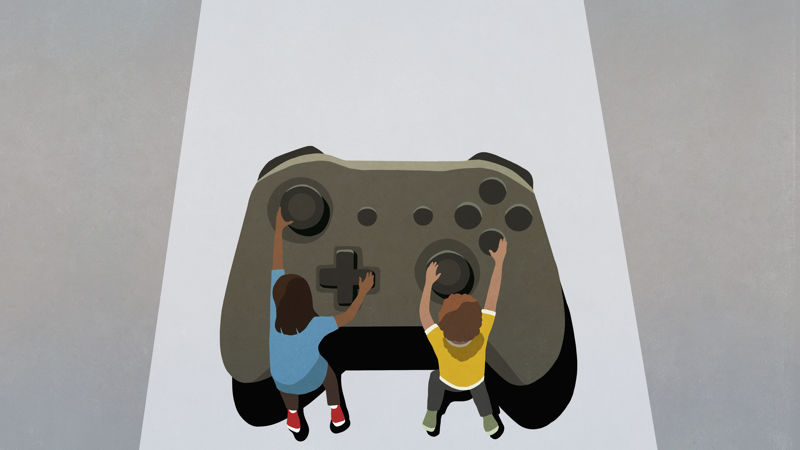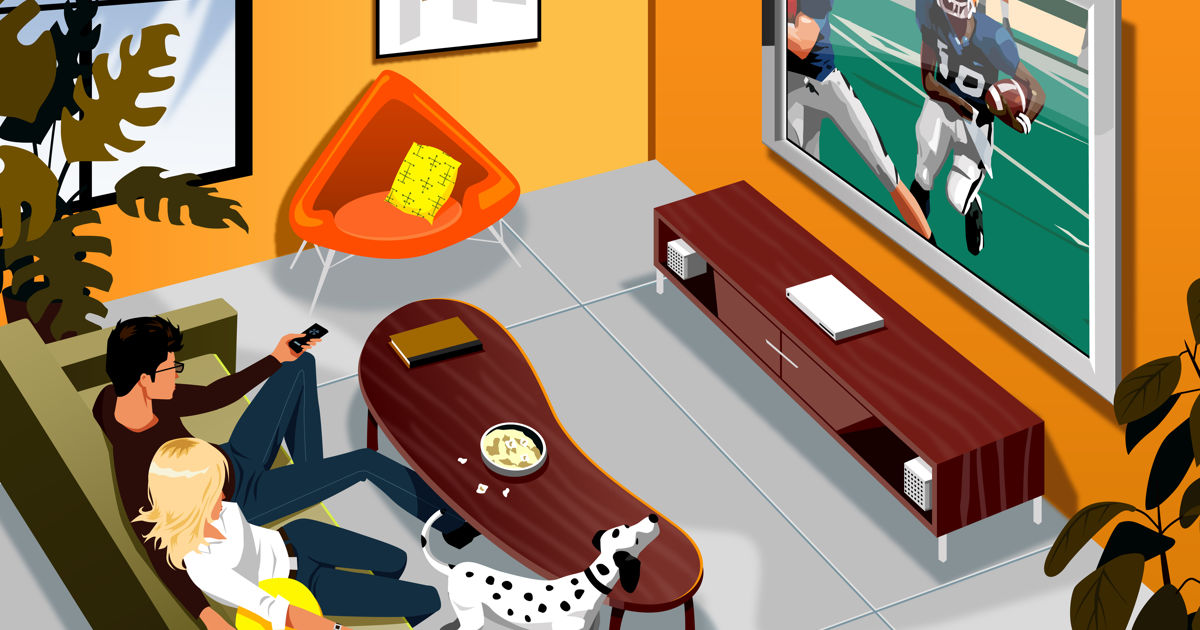Why no one cares about ads any more (with one significant exception)
Collective experiences can super-charge an ad but, says The Moon Unit, with the advent of streaming platforms and the fragmentation of viewing habits, those experiences are increasingly hard to come by... but not impossible.
When you make an ad, you don’t exactly expect it to have the longevity of the Great Pyramid of Giza. You also don’t expect people to care about it like they care about their friends, their children, or the situation in the Middle East.
You do hope they’ll care a bit but, sadly, as you’ll have noticed, they usually don’t.
Today’s ads are released into the void. They go unloved, undiscussed, unnoticed.
Today’s ads are released into the void. They go unloved, undiscussed, unnoticed. And the reason people don't care about ads any more is the same reason they don't care so much about TV any more – they know they're watching on their own.

Above: We felt a special feeling when we were watching Seinfeld because we knew everyone else was watching it with us.
What humans value most is collective experiences, not individual ones. That explains the success of organised religion, orgies, social media, riots and sporting events.
Back in the day, we felt a special feeling when we were watching Seinfeld or the news (and by extension, the ads within them). It was the feeling that everyone else was watching it with us. And we loved that.
The writer of this article used to be one of those kids who ran around the school playground singing jingles from the adverts. And it wasn’t just me. Ads were part of our shared language, just like the catchphrases from comedy shows or movies.
Collective experiences... explain the success of organised religion, orgies, social media, riots and sporting events.
Every time we imitate Arnie (“I’ll be back”) or Chandler Bing (“could you be any more annoying?”) or a Wendy’s ad (“where’s the beef?”) we’re using that shared snippet of culture to communicate with others. The communication is only possible because we know the other person has seen it too.
Today there are so many shows it's very possible no one else we know will have seen the one we’re watching. In 2009, there were 210 scripted shows on US television, by 2022, there were 600. I Love Lucy (1950s), at its peak, was watched by an incredible 67% of Americans, whereas today’s top-rated US show – The Big Bang Theory – gets just an 11% share.

Above: The viewing figures for the BBC's soap, EastEnders, have declined tenfold since 1986.
Last year, only 4% of US adults watched the Oscars. The story is the same worldwide. In the UK, for example, there are still occasional collective viewing experiences, such as Queen Elizabeth II’s funeral, and the King’s Coronation, but top-rated soap opera EastEnders has declined tenfold from a peak of 30 million viewers in 1986 to just three million today.
Of course, human nature hasn’t changed. We still crave collective experiences, it’s just we’re not getting them from TV any more. Instead we’re sharing memes, and playing video games together. Fortnite, for example, has become a worldwide phenomenon, amassing 500 million players across the globe in 2023.
Human nature hasn’t changed. We still crave collective experiences, it’s just we’re not getting them from TV any more.
Nowadays, people are far more likely to share memes than discuss ads. In fact, memes have become so socially significant, they are now being studied by science. The one big exception to the decline in collective viewing experiences? Sports events. Of the 20-most-watched US TV shows of all time, 19 have been Super Bowls.
There’s a reason the cost of a 30-second ad spot during this year’s Super Bowl hit $7 million. The price doesn’t make sense on the numbers alone, but it does when you factor in the cultural resonance.
Back when USA Today began reviewing the Super Bowl ads, in 1989, this was considered a weird niche to cover. Today, every media outlet on the planet reviews the Super Bowl ads because they’re one of the last remaining collective viewing experiences, which makes people disproportionately interested in them, and keen to talk about them.
Credits
powered by
- Agency Highdive Advertising/Chicago
- Production Company O Positive
- Director Jim Jenkins
-
-
Unlock full credits and more with a Source + shots membership.
Credits
powered by
- Agency Highdive Advertising/Chicago
- Production Company O Positive
- Director Jim Jenkins
- Executive Producer/Producer Marc Grill
- Executive Producer Ralph Laucella
- Editing Cutters/USA
- Executive Post Producer Heather Richardson
- Head of Post Production Patrick Casey / (Head of Production)
- Editor Tim LoDolce
- Assistant Editor Jack Taylor
- Assistant Editor Jackie Cohen
- Color Rare Medium
- Color Managing Director/Color Executive Producer Heath Raymond
- Colorist Fergus McCall
- VFX Parliament VFX
- Head of VFX Production Katherine Maidment
- VFX Producer Brett Grisham
- VFX Supervisor Nathan Kane
- VFX Creative Lead Philip Ineno
- VFX Creative Lead Brandon Thomas
- Motion Design/Graphics Sarofsky
- Graphics Managing Director Erin Sarofsky
- Executive Graphics Producer Steven Anderson
- Graphics Producer Kelsey Hynes
- Graphics Creative Director Stefan Draht
- Music Butter Music & Sound
- Music Chief Creative Officer Andrew Sherman
- Executive Music Producer Renee Masse
- Music Executive Creative Director Dan Zank
- Music Producer Warren Wolfe
- Composer Nat Jenkins
- Sound Another Country
- Audio Managing Director Tim Konn
- Executive Audio Producer Louise Rider
- Sound Designer/Audio Mixer Peter Erazmus
- Audio Producer Josh Hunnicutt
- Assistant Audio Mixer Brett Rossiter
- Senior Producer Joshua Zilm
- Talent Arnold Schwarzenegger
- CEO/Co-Founder Megan Lally
- Senior Producer David Burke
- Chief Creative Officer/Co-Founder Chad Broude
- Creative Director Charlie Rogucki
- Chief Creative Officer/Co-Founder Mark Gross
- DP Claudio Miranda
- Executive Creative Director Pat Burke
- Production Designer Jason Edmonds
- Executive Creative Director Chuck Rachford
- Group Creative Director Brian Culp
- Group Creative Director Katie Bero
- Creative Director Ben Doessel
- Creative Director James Lee
- Creative Director Andrew Lincoln
- HP Jen Passaniti
- Executive Producer Adam Battista
- Executive Producer Will St Clair
- Executive Producer Luke LiManni
- Producer Chris Totzke
- Producer Steph Cotherman
- Producer Austin Neely
- VFX Producer Drew Beck
- Producer Alfredo Rivera
- Art Director Sydney Cohen
- Copywriter Jordan Fishel
- Junior Art Director Kyle Brubaker
- Junior Copywriter Emmett Sullivan
- Talent Danny DeVito

Credits
powered by
- Agency Highdive Advertising/Chicago
- Production Company O Positive
- Director Jim Jenkins
- Executive Producer/Producer Marc Grill
- Executive Producer Ralph Laucella
- Editing Cutters/USA
- Executive Post Producer Heather Richardson
- Head of Post Production Patrick Casey / (Head of Production)
- Editor Tim LoDolce
- Assistant Editor Jack Taylor
- Assistant Editor Jackie Cohen
- Color Rare Medium
- Color Managing Director/Color Executive Producer Heath Raymond
- Colorist Fergus McCall
- VFX Parliament VFX
- Head of VFX Production Katherine Maidment
- VFX Producer Brett Grisham
- VFX Supervisor Nathan Kane
- VFX Creative Lead Philip Ineno
- VFX Creative Lead Brandon Thomas
- Motion Design/Graphics Sarofsky
- Graphics Managing Director Erin Sarofsky
- Executive Graphics Producer Steven Anderson
- Graphics Producer Kelsey Hynes
- Graphics Creative Director Stefan Draht
- Music Butter Music & Sound
- Music Chief Creative Officer Andrew Sherman
- Executive Music Producer Renee Masse
- Music Executive Creative Director Dan Zank
- Music Producer Warren Wolfe
- Composer Nat Jenkins
- Sound Another Country
- Audio Managing Director Tim Konn
- Executive Audio Producer Louise Rider
- Sound Designer/Audio Mixer Peter Erazmus
- Audio Producer Josh Hunnicutt
- Assistant Audio Mixer Brett Rossiter
- Senior Producer Joshua Zilm
- Talent Arnold Schwarzenegger
- CEO/Co-Founder Megan Lally
- Senior Producer David Burke
- Chief Creative Officer/Co-Founder Chad Broude
- Creative Director Charlie Rogucki
- Chief Creative Officer/Co-Founder Mark Gross
- DP Claudio Miranda
- Executive Creative Director Pat Burke
- Production Designer Jason Edmonds
- Executive Creative Director Chuck Rachford
- Group Creative Director Brian Culp
- Group Creative Director Katie Bero
- Creative Director Ben Doessel
- Creative Director James Lee
- Creative Director Andrew Lincoln
- HP Jen Passaniti
- Executive Producer Adam Battista
- Executive Producer Will St Clair
- Executive Producer Luke LiManni
- Producer Chris Totzke
- Producer Steph Cotherman
- Producer Austin Neely
- VFX Producer Drew Beck
- Producer Alfredo Rivera
- Art Director Sydney Cohen
- Copywriter Jordan Fishel
- Junior Art Director Kyle Brubaker
- Junior Copywriter Emmett Sullivan
- Talent Danny DeVito
Above: State Farm’s hilarious Like a Good Neighbaaa, was the number one spot of Super Bowl 2024, as ranked by USA Today’s Ad Meter.
Here’s how The New York Times ranked 2024 Super Bowl ads. It’s only when we know that other people are seeing our ads, and talking about them, that we can know they care about them.
If you want people to care about your work, the lesson seems to be, you have to make a Super Bowl ad.
So, if you want people to care about your work, the lesson seems to be that, quite simply, you have to make a Super Bowl ad. Or possibly a Christmas ad in the UK and Australia, since these also get talked about - and viewed - even more on media and social media platforms than they do on TV.
But, mostly, collective viewing is now only about sports. It's all we have left. And the good news is that this is an Olympics year, which brings many more opportunities for collective TV.
Here’s to Paris.
)




 + membership
+ membership







